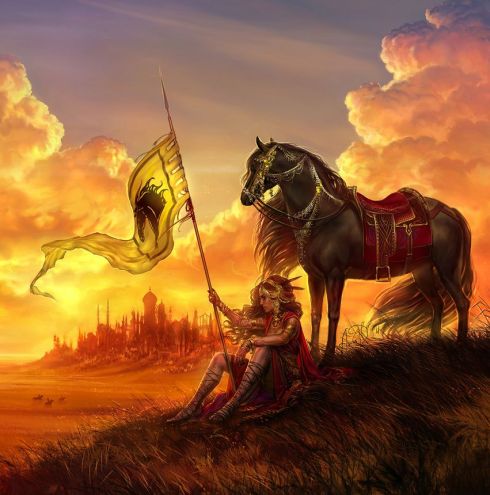Difference between revisions of "Paladin's Warhorse"
Tao alexis (talk | contribs) |
Tao alexis (talk | contribs) |
||
| Line 15: | Line 15: | ||
== Description == | == Description == | ||
| − | |||
The warhorse is usually a destrier, or heavy warhorse, of enormous size; typically it measures 17 to 18 hands tall, 2,300 lbs., with flanks that make for easy riding and a steady, smooth and even bearing. The hindquarters are powerful, allowing it to easily react and spring, to stop, spin, turn or sprint forward. Physically, it has a short back and well-muscled loins, strong bones and a well-arched neck. The mane and tail hair is typically lush and quite long, though it can be trimmed if desired. | The warhorse is usually a destrier, or heavy warhorse, of enormous size; typically it measures 17 to 18 hands tall, 2,300 lbs., with flanks that make for easy riding and a steady, smooth and even bearing. The hindquarters are powerful, allowing it to easily react and spring, to stop, spin, turn or sprint forward. Physically, it has a short back and well-muscled loins, strong bones and a well-arched neck. The mane and tail hair is typically lush and quite long, though it can be trimmed if desired. | ||
Revision as of 05:13, 19 August 2023
The paladin's warhorse, also known as a "meara," is an unusual breed of wild horse, the largest of which are chosen to be worthy of paladins by holy spirits called "a luris," or beings of light. Upon entering the meara, the spirit acts as a familiar within the warhorse; it and the warhorse together await the paladin whom they are destined to serve.
This explains the meara's intelligence and long life (it won't die before the paladin does), as well as the warhorse's eternal service to the paladin once his or she has reached the 4th level of experience.
Communication
Upon reaching that milestone, the paladin's warhorse shall present itself and the first opportunity, usually within 3-12 hours — unless the paladin is in a place that horses cannot enter, such that might be the case within an underground dungeon. Thereafter, the warhorse acts as companion, mount and protector, not only of the paladin but also of anyone the paladin loves. It shares an understanding of the paladin's needs that resembles ESP ... but while the warhorse may understand the paladin perfectly, this communication isn't reciprocal.
The paladin must somehow communicate with the warhorse as he or she would any other equine — though naturally, the warhorse can express its thoughts intelligently through body language. As the warhorse understands the paladin's spoken word, it can also be asked questions, to sort out what the warhorse might know. Of course, if the paladin finds a way to speak with animals, a full understanding can be reached.
Allies
The warhorse shall recognise the paladin's connection to his or her companions, and its importance, and so in addition the horse will seek to protect such persons also. It won't abandon the paladin to do so, but can make choices about the paladin's well-being and that of other persons in the immediate moment.
The warhorse is ready to allow other riders as the paladin wishes, and always takes care of such persons as well as it's able. This is true even if the warhorse isn't in the paladin's company. For example, if the warhorse were instructed to bear the party's mage to another land or region, the warhorse would willingly do so, for as long as the task requires ... but thereafter it would return to the paladin, whose location it always knows by means of the spirit dwelling within the warhorse.
Description
The warhorse is usually a destrier, or heavy warhorse, of enormous size; typically it measures 17 to 18 hands tall, 2,300 lbs., with flanks that make for easy riding and a steady, smooth and even bearing. The hindquarters are powerful, allowing it to easily react and spring, to stop, spin, turn or sprint forward. Physically, it has a short back and well-muscled loins, strong bones and a well-arched neck. The mane and tail hair is typically lush and quite long, though it can be trimmed if desired.
It's nature is to ease whatever particular gait is being employed. If the paladin is too small in stature for such an animal, the paladin's warhorse might be a medium warhorse, some 16 hands high and a mere 1,900 lbs. Overall, however, the warhorse's performance is about the same.
In all cases the warhorse appears fine and very strong, commonly of a colour that best suits the paladin's taste. For game purposes, the player is free to choose markings and colour if desired; in any case, the colour will be startlingly rich, so that even by day or night the animal appears glossy and healthy. The warhorse's gender may also be chosen. Male warhorses are always be geldings.
Advantages
When defending itself without a rider, the warhorse will rear upon its hind legs and kick forward, or kick backwards with its hooves. The warhorse can attack either forward or backward in a given round, but not both. If bearing a rider, the animal will be able to attack with its teeth.
In caretaking a rider, the warhorse doubles the amount of horseback riding knowledge possessed by whatever rider is mounted. This is true with regards to horse handling or horse-mounted combat. If the rider has less than 10 points of knowledge, and depends upon assisted riding, the warhorse will gently carry the rider as a passenger.
Other Notes
The warhorse cannot be sold or given permanently to other persons. When its tasks are done, it will always return to its liege paladin. If the horse is deliberately sent away forever, it will wither and die within 60 to 90 days.
